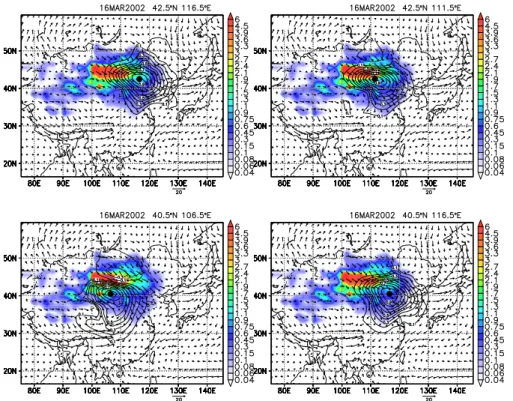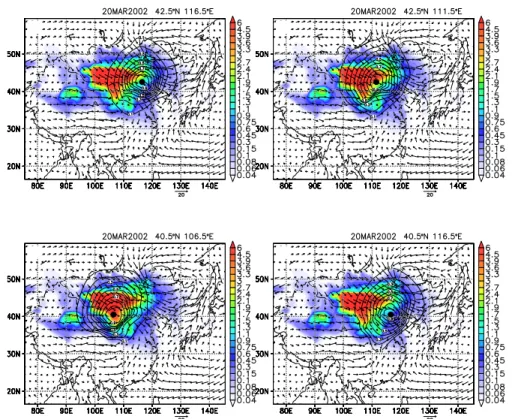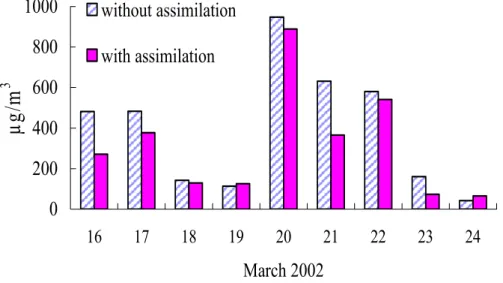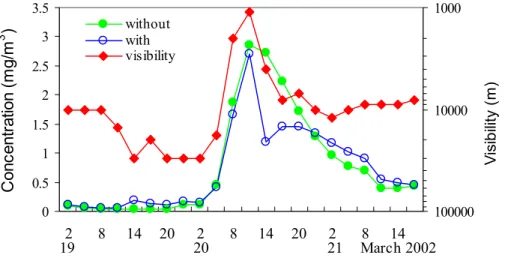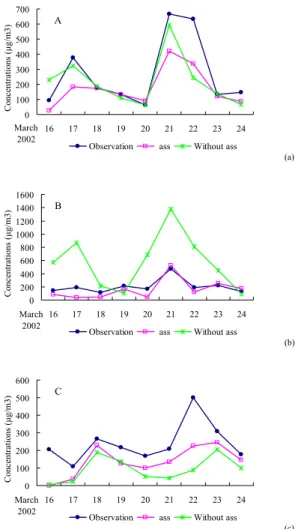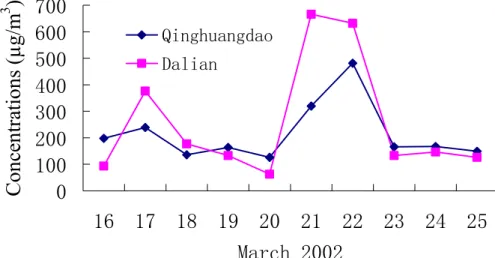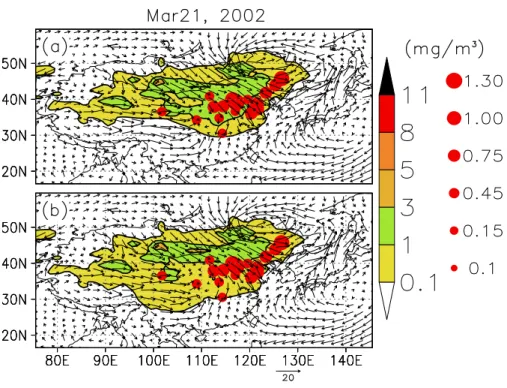HAL Id: hal-00303199
https://hal.archives-ouvertes.fr/hal-00303199
Submitted on 3 Dec 2007HAL is a multi-disciplinary open access
archive for the deposit and dissemination of sci-entific research documents, whether they are pub-lished or not. The documents may come from teaching and research institutions in France or abroad, or from public or private research centers.
L’archive ouverte pluridisciplinaire HAL, est destinée au dépôt et à la diffusion de documents scientifiques de niveau recherche, publiés ou non, émanant des établissements d’enseignement et de recherche français ou étrangers, des laboratoires publics ou privés.
A data assimilation method of the Ensemble Kalman
Filter for use in severe dust storm forecasts over China
C. Lin, Z. Wang, J. Zhu
To cite this version:
C. Lin, Z. Wang, J. Zhu. A data assimilation method of the Ensemble Kalman Filter for use in severe dust storm forecasts over China. Atmospheric Chemistry and Physics Discussions, European Geosciences Union, 2007, 7 (6), pp.17511-17536. �hal-00303199�
ACPD
7, 17511–17536, 2007Data assimilation with the EnKF for
dust forecast C. Lin et al. Title Page Abstract Introduction Conclusions References Tables Figures ◭ ◮ ◭ ◮ Back Close Full Screen / Esc
Printer-friendly Version Interactive Discussion
EGU
Atmos. Chem. Phys. Discuss., 7, 17511–17536, 2007 www.atmos-chem-phys-discuss.net/7/17511/2007/ © Author(s) 2007. This work is licensed
under a Creative Commons License.
Atmospheric Chemistry and Physics Discussions
A data assimilation method of the
Ensemble Kalman Filter for use in severe
dust storm forecasts over China
C. Lin1,2, Z. Wang1, and J. Zhu1
1
LAPC/NZC, Institute of Atmospheric Physics, Chinese Academy of Sciences, Beijing, China
2
Graduate University of Chinese Academy of Sciences, Beijing, China Received: 17 September 2007 – Accepted: 13 November 2007
– Published: 3 December 2007
ACPD
7, 17511–17536, 2007Data assimilation with the EnKF for
dust forecast C. Lin et al. Title Page Abstract Introduction Conclusions References Tables Figures ◭ ◮ ◭ ◮ Back Close Full Screen / Esc
Printer-friendly Version Interactive Discussion
EGU
Abstract
An Ensemble Kalman Filter (EnKF) data assimilation system was developed for a re-gional dust transport model. This paper applied the EnKF method to investigate mod-eling severe dust storm episodes occurred in March 2002 over China based on surface observations of dust concentrations to explore its impacts on forecast improvement. A
5
series of sensitivity experiments using our system reveals that the EnKF is an advanced assimilation method to afford better initial conditions with surface observed PM10 in
North China and lead to improved forecasts of dust storms, but forecast with large errors can be made by model errors. This result illustrates that it requires identifying and correcting model errors during the assimilation procedure in order to significantly
10
improve forecasts. Results also show that the EnKF should use a large inflation pa-rameter to obtain better model performance and forecast potential. Furthermore, the ensemble perturbations generated at the initial time should include enough ensemble spreads to represent the background error after several assimilation cycles.
1 Introduction
15
Dust storms have drawn much concern during the past two decades for its various impacts on atmospheric environment, biogeochemical cycles, radiative balance and human health. In recent years, many observations have been carried out to study Asian dust storms and much progress has been achieved and improved the understanding of climatic and synoptic features of soil dust aerosols (Murayama et al., 2001; Mori et
20
al., 2002; Sugimoto, 2002; Sugimoto et al., 2002; Zhang et al., 2003). On the other side, for the special ability to provide high spatial and temporal resolution forecasts of Asian dust and reproduce many important observational facts, several numerical models have been developed and used to study the deflation, transport and budget of soil dust over East Asia (Wang et al., 2000; Shao, 2001; Song et al., 2001; Uno et al.,
25
ACPD
7, 17511–17536, 2007Data assimilation with the EnKF for
dust forecast C. Lin et al. Title Page Abstract Introduction Conclusions References Tables Figures ◭ ◮ ◭ ◮ Back Close Full Screen / Esc
Printer-friendly Version Interactive Discussion
EGU
al., 2004). The intercomparison study (DMIP) involving eight dust emission/transport models over Asia found that the model results correctly captured the major dust onset and cessation timing at each observation site. However, the maximum concentration of each model was 2–4 times different (Uno et al., 2006), clearly indicating that modeling results of dust storms with these models have significant errors.
5
Numerical forecasts of dust storms suffer from uncertainties of initial conditions, emission and model errors. Simply comparing model forecast to observations can not separate these uncertainties. Using data assimilation technique we can firstly re-duce uncertainty of initial conditions that may lead to improved forecasts and secondly better examine model errors by comparing to observations since the uncertainty of
ini-10
tial conditions can be maximally reduced by assimilation of observations at initial times. Recently, Yumimoto et al. (2007) applied a four-dimensional variation (4-DVAR) to a re-gional dust model to assimilate NIES Lidar observations over East Asia to inverse Asian dust emissions and shown better estimation capability. Niu et al. (2007) developed a 3-DVAR using satellite retrieved dust loading and surface visibility in CUACE/Dust
fore-15
cast system and showed the capability of short-term forecast improvement. These both indicate the important role of data assimilation to combine the observations and model in dust forecast. In these methods, the background error statistics, one of the most important items in data assimilation, are usually assumed to be spatially homo-geneous, horizontally isotropic, and temporally stationary, which may disagree with the
20
true ones that may have significant flow-dependence, especially for meso-scale mo-tions. Although the background error statistics can evolve implicitly in 4-DVAR during the time window, the complexity of constructing the adjoint matrix and the expensive computation in 4-DVAR usually prevent it from common application especially for com-plicated models.
25
In this study we perform Ensemble Kalman Filter (EnKF) data assimilation experi-ments during some severe dust storm episodes in China using surface observations of dust concentrations and a realistic model in order to explore the impacts on fore-cast improvement. The EnKF is an advanced, flexible and widely used technique
ACPD
7, 17511–17536, 2007Data assimilation with the EnKF for
dust forecast C. Lin et al. Title Page Abstract Introduction Conclusions References Tables Figures ◭ ◮ ◭ ◮ Back Close Full Screen / Esc
Printer-friendly Version Interactive Discussion
EGU
for data assimilation which can calculate the flow-dependent statistics from the en-semble forecasts (Evensen, 1994; Houtekamer and Mitchell, 1998, 2001; Mitchell and Houtekamer, 2000, 2002; Houtekamer et al., 2005; Whitaker et al., 2002; Lorenc, 2003; Evensen, 2003, 2006). However EnKF has not been applied in severe dust storm fore-casts, for the first time, we made an initial effort to explore the potential problems of
5
this issue with EnKF.
2 Data source and model description analysis
2.1 Data
Daily averaged PM10 concentrations observed by the State Environmental Protection Administration, China (SEPA) from 15 March 2002 to 25 March 2002 are used for
10
assimilation and validation. For the PM10 observations reflect not only dust aerosol but
also anthropogenic aerosol, before they are used, the PM10 observations are selected according to the surface synoptic observations about dust events every 3 h from China Meteorological administration (CMA). If there are at least one occurrence of floating dust phenomenon observed at stations located within 1 latitude degree around the
15
PM10 station during the day, the contribution of PM10 observation of this station of the day is considered mainly coming from dust and selected for assimilation and validation, otherwise it would be discarded. The number of qualified PM10 observations after
quality control is listed in Table 1, clearly indicating the influence of dust storms on the air quality. Figure 1 presents the distribution of observation sites (green dots) passing
20
through quality control and used for assimilation on 22 March, and the red rectangles represent three selected independent sites that only used for verification.
The Lidar observation at Beijing was performed at the Sino-Japan Friendship Cen-ter for Environmental Protection during the same period (Sugimoto et al., 2003). The visibility observations are the surface observations from the China Metrological
Admin-25
ACPD
7, 17511–17536, 2007Data assimilation with the EnKF for
dust forecast C. Lin et al. Title Page Abstract Introduction Conclusions References Tables Figures ◭ ◮ ◭ ◮ Back Close Full Screen / Esc
Printer-friendly Version Interactive Discussion
EGU
2.2 Model description and setting
The regional dust transport model (Wang et al., 2000) included deflation, transport, diffusion, and removal processes during the life cycle of the yellow sand particles. This model had been successfully used to study atmospheric trace gases and particles, such as SOx, dust, O3and acid rain over East Asia (Wang et al., 2000, 2002; Uematsu 5
et al., 2003). The advanced deflation module of yellow sand has been designed after detailed analysis of the meteorological conditions, landform, and climatology from daily weather report at about 300 local weather stations in north China. Details about the model could be referred to Wang et al. (2000). The simulation domain used ranges from (75◦E, 16◦N) to (146◦E, 60◦N) consisting of 72 by 45 grid cells horizontally and
10
18 vertical layers is shown in Fig. 1.
A heavy dust storm occurred in northern China and invaded Beijing on 20 March 2002, with peak concentration of Total Suspended Particles (TSP) reaching 10.9 mg m−3, 54 times higher than the National Air Quality Standard of China (Sun et al., 2004). Model analysis with Lidar observation of this dust storm in Beijing
re-15
vealed the source and transport path of the dust and further explained the reasons for the occurrence of such extremely high dust concentration (Sugimoto et al., 2003). This dust storm not only swept over most parts of China but also reached Korea and Japan. Using model simulation, Park et al. (2003) studied dust emissions from the source areas of this dust storm. In addition, Shao et al. (2003) simulated this dust
20
storm with an integrated modeling system and found the model could predict well the spatial pattern and temporal evolution of dust concentration. Han et al. (2004) de-veloped a size-segregated aerosol model and coupled this with a regional air quality model to simulate the dust storms of 15–24 March 2002. In this study, we developed a regional chemical transport model combined with EnKF data assimilation method to
25
improve the forecast performance and to investigate the vertical structure of this super dust storm during the period of 15–25 March 2002 in East Asia.
ACPD
7, 17511–17536, 2007Data assimilation with the EnKF for
dust forecast C. Lin et al. Title Page Abstract Introduction Conclusions References Tables Figures ◭ ◮ ◭ ◮ Back Close Full Screen / Esc
Printer-friendly Version Interactive Discussion
EGU
3 Data assimilation with Ensemble Kalman Filter method
The basic idea of the EnKF (Evensen, 1994) is to construct a Monte Carlo ensemble such that the mean of the ensemble is the best estimate, and the ensemble error covariance is a good estimate of the forecast error covariance.
At the current assimilation time, the EnKF assumes that the forecast error is
ran-5
domly sampled by an ensemble of forecasts, denoted by xb1, xbx, · · ·, xbm. The ensemble mean is defined by xb=m−1
m P i=1
xbi . The ensemble perturbation from the mean for i-th member is x′ib=x
b i −x
b
. The EnKF performs an ensemble of parallel assimilation cir-cles, i =1, . . . , m, with each member update to different realization of the observations:
xai=xbi + ˆK(yi −H(xbi)). (1)
10
In Eq. (1), yi≈N(0, R) is a perturbation from observations y. And the gain matrix ˆK can be formed without ever explicitly computing the full forecast error covariance (Evensen, 1994; Houtekamer and Mitchell, 1998) using the following equations:
ˆ K = ˆPbHT(H ˆPbHT + R)−1, (2) ˆ PbHT = 1 m −1 m X i=1 x′ ib(H(xb i) − H(xb)) T, (3) 15 H ˆPbHT = 1 m −1 m X i=1 (H(xbi ) − H(xb))(H(xb i ) − H(xb)) T. (4)
In Eq. (3) and Eq. (4),
H(xb) = 1 m m X i=1 H(xbi).
ACPD
7, 17511–17536, 2007Data assimilation with the EnKF for
dust forecast C. Lin et al. Title Page Abstract Introduction Conclusions References Tables Figures ◭ ◮ ◭ ◮ Back Close Full Screen / Esc
Printer-friendly Version Interactive Discussion
EGU
Once each member is updated, we take the mean xa=m−1 m P i=1
xai as the analysis. In this study, the initial background ensemble perturbations are generated by adding random amplitude and phase shifts to the first-guess x(x, y, z) as follows:
xi(x, y, z) = (1 + δi) x (x + εi, y + ωi, z+ ηi) where,
5
δ ∈ N(0, a2), ε ∈ N(0, lx2), ω ∈ N(0, ly2), η ∈ N(0, lz2),
and the observations are also perturbed with a normal distributed noise with zero mean and variance R.
A parameter α≥1 is introduced to allow for inflating the forecast error variance since the ensemble spread itself may be too small to draw the model states to the
observa-10
tions, then Eq. (2) will be rewritten as
ˆ
K = α ˆPbHT(αH ˆPbHT+R)−1. (5)
In addition, the value for dust concentrations should be positive that the analysis would be set to be zero if it is negative.
4 Results
15
Two sets of run with and without assimilation scheme addressed above were performed to test the performance of the EnKF used in the regional transport model of dust. Firstly, the tests were performed during 15–25 March 2002 once a day with initial perturbations generated on 03:00 UTC 15 March to check the overall impact of the assimilation on 24 h forecasts.
20
To convey an impression of the anisotropic nature of the horizontal correlations, we present some examples of horizontal correlations of surface concentrations with re-spect to the points shown with the black dots in Fig. 2 and Fig. 3. The correlations are
ACPD
7, 17511–17536, 2007Data assimilation with the EnKF for
dust forecast C. Lin et al. Title Page Abstract Introduction Conclusions References Tables Figures ◭ ◮ ◭ ◮ Back Close Full Screen / Esc
Printer-friendly Version Interactive Discussion
EGU
directly estimated from 50-member ensemble on 03:00 UTC 16 March and 20 March. It can be seen that the spatial structure are dependent on the flow which displays the most important property of EnKF compared to other traditional data assimilation meth-ods such as optimal interpolation (OI) and three-dimension variational assimilation (3-D-Var). In OI and 3-D-Var algorithms, the statistics in background error covariance
5
are generally taken to be isotropic and largely homogeneous with little variation in time which is not consistent with the real systems.
The root mean square (RMS) difference between daily averaged PM10observations
and the simulated daily averaged 24 h forecasts (d<10µm) and the analysis at three independent observation stations were calculated during 16–25 March 2002 (Fig. 4). It
10
can be seen that the RMS difference of the assimilated results are much smaller than that without assimilation totally, which clearly shows the potential ability of the EnKF method used in the regional transport model. The RMS difference for all sites is shown in Fig. 5. The difference between observations and the 24 h forecasts with assimilation are smaller than those without assimilation, showing the forecast are also improved
15
after EnKF assimilation but not obviously for the whole area.
An independent Lidar observed the dust extinction coefficients in Beijing in the same period. Figure 6 gives comparison between Lidar observations, model simulation with-out assimilation and assimilated dust concentrations. These results illustrated that to use the EnKF method only assimilating surface PM10 concentration changed the
ver-20
tical structures of dust distribution and significantly improved the modeling results in Beijing when comparing with Lidar observations. Two peaks of dust concentration dis-tribution exhibited on 20 March in Beijing with EnKF assimilation agrees well with the dust extinction coefficients. This may be due largely to the vertical structure in back-ground error covariance calculated from the ensemble, which propagates the surface
25
PM10 observations to high levels.
Surface dust concentrations and visibility are compared in Beijing in Fig. 7. On 20 March, the two troughs of visibility correspond to the two peaks of dust concentrations with assimilation but just one peak of the simulated results without assimilation, and the
ACPD
7, 17511–17536, 2007Data assimilation with the EnKF for
dust forecast C. Lin et al. Title Page Abstract Introduction Conclusions References Tables Figures ◭ ◮ ◭ ◮ Back Close Full Screen / Esc
Printer-friendly Version Interactive Discussion
EGU
bigger trough corresponding to the higher peak. This makes clear that the Ensemble Kalman Filter plays an important role on it. Figure 8 shows the assimilated results of surface dust aerosols (d<10 µm) with assimilation once a day at three independent ob-served stations respectively (A, B, C as shown in Fig. 1). It shows that the assimilation analyses are closer to the observations than the simulation without EnKF assimilation
5
especially in Shijiazhuang (B) and Shanghai (C). The assimilated results in Dalian (A) are not so closer to the observations as the simulation, which may be due to the sparse observations nearby and the low resolution of model. If the observational network is relatively dense the assimilated results are better, such as the results of B and C.
We here select point A (Dalian) to explain it. For Dalian, the analyses on 17 March
10
and 21 March are worse than simulation, the others are comparable to the simulation. From Fig. 9 we can see that the variation of observed PM10of two close points (Dalian
and Qinhuangdao) are quite different, especially on 17 March and 21 March, which indicates that spatial variability of the dust storm is very strong and the correlation coefficient is small in fact. However, the resolution of model is 1◦×1◦, which may be too
15
low to resolve the spatial variability of such processes, and then the dust concentrations calculated from the model are similarly distributed in a relatively large region. So the correlations estimated directly from the ensemble forecasts are distributed in a relative large region, which does not agree with the real one and it can bias the assimilated results. Figure 10 gives the correlation distribution of Dalian on 17 March (upper panel)
20
and 21 March (bottom panel), and the black dot and the green dot denote the position of Dalian and Qinghuangdao respectively. We can see that the correlation coefficients of these two points are larger than 0.8. Therefore, the method to solve it is to increase the model resolution or to try to get much denser observations.
Figure 11 and Fig. 12 give surface distribution of dust concentration over East Asia
25
without (a) and with assimilation (b) on 20 and 21 March, respectively. Compared with the PM10 observations, the forecast concentrations are much larger than the obser-vations, especially in the north part of North China, while smaller in the south part. After EnKF assimilation, the average of one-day forecast concentrations decreases in
ACPD
7, 17511–17536, 2007Data assimilation with the EnKF for
dust forecast C. Lin et al. Title Page Abstract Introduction Conclusions References Tables Figures ◭ ◮ ◭ ◮ Back Close Full Screen / Esc
Printer-friendly Version Interactive Discussion
EGU
the north part and increases in the south part of North China, which compensates the model deficiency.
5 Conclusion and discussion
The correlation patterns of several selected points shown in Fig. 2 and Fig. 3 prove that EnKF can calculate the flow-dependent statistics which may not be expected in other
5
traditional assimilation techniques. To use surface PM10 observations for data
assim-ilation of dust storm, it is necessary to select them according to the surface synoptic dust events reports. This study shows that, using advanced method such as EnKF, the assimilation of surface PM10observations can provide better initial conditions and lead
to improved forecasts of dust storms. However the forecasts still have large space to
10
be further improved. First, the current PM10 observations that are reported to in SEPA
are only daily-averaged. For fast changing processes such as dust storms, this study shows that much more frequent observations are needed to correctly describe the fast evolution structure. And denser observational networks are also necessary to specify the spatial variability of such process as air pollution (see Fig. 8). Second, the model
15
errors are main contributions to forecast errors at least at some regions. The assim-ilation can provide good initial conditions, but forecast with large errors can be made by model errors (see Fig. 5). Therefore it requires identifying and correcting model er-rors during the assimilation procedure in order to significantly improve forecasts. This may be achieved by either four-dimensional variation method or augmented EnKF. This
20
should be a priority for further studies in this direction.
The dust concentrations vary very rapidly and are generally independent in differ-ent dust process. Therefore, the ensemble perturbations generated at the initial time may not have enough ensemble spread to represent the background error after sev-eral assimilation cycles. In this study we found it is necessary to use a large inflation
25
parameter (α defined in Eq.5). In addition, we also found that the analysis may have negative values for dust concentrations. We use a simple way that sets negative values
ACPD
7, 17511–17536, 2007Data assimilation with the EnKF for
dust forecast C. Lin et al. Title Page Abstract Introduction Conclusions References Tables Figures ◭ ◮ ◭ ◮ Back Close Full Screen / Esc
Printer-friendly Version Interactive Discussion
EGU
to zero. More skillful methods should be explored in further studies.
Acknowledgements. This study was supported by Chinese Academy of Sciences
(KZCX3-SW-341 and KZCX2-YW-202) and Natural Science Foundation of China (40533017). We are appreciative of N. Sugimoto for providing Lidar data, and SEPA providing observed PM10data.
References
5
Evensen, G.: Sequential data assimilation with a nonlinear quasigeostrophic model using Monte Carlo methods to forecast error statistics, J. Geophys. Res., 99, 10 143–10 162, 1994. Evensen, G.: The Ensemble Kalman Filter: Theoretical Formulation and Practical
Implementa-tion, Ocean Dynam., 53, 343–367, 2003.
Evensen, G.: Data Assimilation: The Ensemble Kalman Tilter, Springer, German, 2006.
10
Gong, S. L., Zhang, X. Y., Zhao, T. L., McKendry, I. G., Jaffe, D. A., and Lu, N. M.: Characteriza-tion of soil dust aerosol in China and its transport and distribuCharacteriza-tion during 2001 ACE-Asia: 2. Model simulation and validation, J. Geophys. Res., 108, 4262, doi:10.1029/2002JD002633, 2003.
Han, Z. W., Ueda, H., Matsuda, K., Zhang, R. J., Arao, K., Kanai, Y., and Hasome, H.: Model
15
study on particle size segregation and deposition during Asian dust events in March 2002, J. Geophys. Res., 109, doi:10.1029/2004JD004920, 2004.
Houtekamer, P. L. and Mitchell, H. L.: Data assimilation using an Ensemble Kalman Filter technique, Mon. Wea. Rev., 126, 796–811, 1998.
Houtekamer, P. L. and Mitchell, H. L.: A sequential Ensemble Kalman Filter for atmospheric
20
data assimilation, Mon. Wea. Rev., 129, 123–137, 2001.
Houtekamer, P. L., Mitchell, H. L., Pellerin, G., Buehner, M., Charron, M., Spacek, L., and Hansen, B.: Atmospheric Data Assimilation with an Ensemble Kalman Filter: Results with Real Observations, Mon. Wea. Rev., 133, 604–620, 2005.
Lorenc, A. C.: The potential of the Ensemble Kalman Filter for NWP–a comparison with 4D-Var,
25
Q. J. R. Meteorol. Soc., 129, 3183–3203, 2003.
Liu, M. L., Westphal, D. L., Wang, S. G., Shimizu, A., Sugimoto, N., Zhou, J., and Chen, Y.: A high-resolution numerical study of the Asian dust storms of April 2001, J. Geophys. Res., 108, 8653, doi:10.1029/2002JD003178, 2003.
ACPD
7, 17511–17536, 2007Data assimilation with the EnKF for
dust forecast C. Lin et al. Title Page Abstract Introduction Conclusions References Tables Figures ◭ ◮ ◭ ◮ Back Close Full Screen / Esc
Printer-friendly Version Interactive Discussion
EGU
Lu, H. and Shao Y. P.: Toward quantitative prediction of dust strorms: an integrated wind erosion modeling system and its application, Environ. Modell. Softw., 16 233–16 249, 2001.
Mitchell, H. L. and Houtekamer, P. L.: An Adaptive Ensemble Kalman Filter, Mon. Wea. Rev., 28, 416–433, 2000.
Mitchell, H. L., Houtekamer, P. L., and Pelerin, G.: Ensemble size, balance, and model error
5
representation in an Ensemble Kalman Filter, Mon. Wea. Rev., 130, 2791–2808, 2002. Mori, I., Nishikawa, M., Quan, H., and Morita, M.: Estimation of the concentration and chemical
composition of kosa aerosols at their origin, Atmos. Environ., 36, 4569–4575, 2002.
Murayama, T., Sugimoto, N., Uno. I., Kinoshita, K., Aoki, K., Hagiwara, N., Liu, Z., Matsui, I., Sakai, T., Shibata, T., Arao, K., Shon, B. J., Won, J. G., Yoon, S. C., Li, T., Zhou, J., Hu, H.,
10
Abo, M., Iokibe, K., Koga, R., and Iwasaka, Y.: Ground-Based Network Observation of Asian Dust Events of April 1998 in East Asia, J. Geophys. Res., 106, 18 345–18 359, 2001. Niu, T., Gong, S. L., Zhu, G. F., Liu, H. L., Hu, X. Q., Zhou, C. H., and Wang, Y. Q.: Data
assimi-lation of dust aerosol observations for CUACE/Dust forecasting system, Atmos. Chem. Phys. Discuss., 7, 8309–8332, 2007,http://www.atmos-chem-phys-discuss.net/7/8309/2007/.
15
Park, S. U. and In, H. J.: Parameterization of dust emission for the simulation of the yellow sand (Asian dust) event observed in March 2002 in Korea, J. Geophys. Res., 108, 4618, doi:10.1029/2003JD003484, 2003.
Shao, Y.: A model of mineral dust emission, J. Geophys. Res., 106, 20 239–20 254, 2001. Shao, Y. P., Yang, Y., Wang, J. J., Song, Z. X., Leslie, L. M., Dong, C. H., Zhang, Z. H., Lin, Z.
20
H., Kanai, Y., Yabuki, S., and Chun, Y.: Northeast Asian dust storms: Real-time numerical prediction and validation, J. Geophys. Res., 108, 4691, doi:10.1029/2003JD003667, 2003. Song, C. H. and Carmichael, G. R.: A three-dimensional modeling investigation of the evolution
processes of dust and sea-salt particles in East Asia, J. Geophys. Res., 106, 18 131–18 154, 2001.
25
Sugimoto, N.: Network observations of Asian dust and anthropogenic aerosols with dual-polarization Mie-scattering lidars, Proc. Int. Laser Radar Conf., 269–271, 2002.
Sugimoto, N., Matsui, I., Shimizu, A., Uno, I., Asai. K., Endoh, T., and Nakajima, T.: Observation of dust and anthropogenic aerosol plumes in the Northwest Pacific with a two-wavelength polarization lidar on board the research vessel Mirai, Geophys. Res. Lett., doi:10.1029/
30
2002GL015112, 2002.
Sun, Y., Zhuang, G., Yuan, H., Zhang, X., and Guo, J.: Characteristics and sources of 2002 super dust storm in Beijing, Chinese Sci. Bull., 49, 7, 698–705, 2002.
ACPD
7, 17511–17536, 2007Data assimilation with the EnKF for
dust forecast C. Lin et al. Title Page Abstract Introduction Conclusions References Tables Figures ◭ ◮ ◭ ◮ Back Close Full Screen / Esc
Printer-friendly Version Interactive Discussion
EGU
Uematsu M., Wang, Z., and Uno, I.: Atmospheric input of mineral dust to the western North Pacific region based on direct measurements and a regional chemical transport model, Geo-phys. Res. Lett., 30, 1342, doi:10.1029/2002GL016645, 2003.
Uno, I., Amano, H., Emori. S., Kinoshita, K., Matsui, I., and Sugimoto, N.: Transpacific yellow sand transport observed in April 1998, J. Geophys. Res., 106, 18 331–18 344, 2001.
5
Uno, I., Wang, Z. F., Chiba, M., Chun, Y. S., Gong, S. L., Hara, Y., Jung, E., Lee, S.-S., Liu, M., Mikami, M., Music, S., Nickovic, S., Satake, S., Shao, Y., Song, Z., Sugimoto, N., Tanaka,T., and Westphal, D. L.: Dust model intercomparison (DMIP) study over Asia: Overview, J. Geophys. Res., 111, D12213, doi:10.1029/2005JD006575, 2006.
Wang, Z. F., Ueda, H., and Huang, M. Y.: A deflation module for use in modeling long-range
10
transport of yellow sand over East Asia, J. Geophys. Res., 105, 26 947–26 958, 2000. Wang, Z., Akimoto, H., and Uno, I.: Neutralization of soil aerosol and its impact on the
distri-bution of acid rain over east Asia: Observations and model results, J. Geophys. Res., 107, 4389, doi:10.1029/2001JD001040, 2002.
Whitaker, J. S. and Hamill, T. M.: Ensemble Data Assimilation without perturbed observations,
15
Mon. Wea. Rev., 130, 1913–1924, 2002.
Yumimoto, K., Uno, I., Sugimoto, N., Shimizu, A., and Satake, S.: Adjoint inverse mod-eling of dust emission and transport over East Asia, Geophys. Res. Lett., 34, L08806, doi:10.1029/2006GL028551, 2007.
Zhang, X. Y., Gong, S. L., Shen, Z. X., Mei, F. M., Xi, X. X., Liu, L. C., Zhou, Z. J., Wang, D.,
20
Wang, Y. Q., and Cheng, Y.: Characterization of soil dust aerosol in China and its transport and distribution during 2001 ACE-ASIA: Network observations, J. Geophys. Res., 108, 4261, doi:10.1029/2002JD002632, 2003.
ACPD
7, 17511–17536, 2007Data assimilation with the EnKF for
dust forecast C. Lin et al. Title Page Abstract Introduction Conclusions References Tables Figures ◭ ◮ ◭ ◮ Back Close Full Screen / Esc
Printer-friendly Version Interactive Discussion
EGU
Table 1. Number of valid PM10 observations after quality control over North China during 15–25 March 2002.
Date 15 16 17 18 19 20 21 22 23 24 25
ACPD
7, 17511–17536, 2007Data assimilation with the EnKF for
dust forecast C. Lin et al. Title Page Abstract Introduction Conclusions References Tables Figures ◭ ◮ ◭ ◮ Back Close Full Screen / Esc
Printer-friendly Version Interactive Discussion
EGU
Fig. 1. The model domain and the observational network . The closed circles indicate positions of those PM10observations used in assimilation cycles on 22 March, while the rectangles are those used for independent verifications.
ACPD
7, 17511–17536, 2007Data assimilation with the EnKF for
dust forecast C. Lin et al. Title Page Abstract Introduction Conclusions References Tables Figures ◭ ◮ ◭ ◮ Back Close Full Screen / Esc
Printer-friendly Version Interactive Discussion
EGU
Figure 2
Fig. 2. Correlations (line contours) of surface concentrations with those at different points denoted by the black dots directly estimated from ensemble perturbations at 03:00 UTC on 16 March 2002. The shaded contour is the simulated surface concentrations of dust particles.
ACPD
7, 17511–17536, 2007Data assimilation with the EnKF for
dust forecast C. Lin et al. Title Page Abstract Introduction Conclusions References Tables Figures ◭ ◮ ◭ ◮ Back Close Full Screen / Esc
Printer-friendly Version Interactive Discussion
EGU
Figure 3 Fig. 3. As in Fig. 2, but at 03:00 UTC on 20 March 2002.
ACPD
7, 17511–17536, 2007Data assimilation with the EnKF for
dust forecast C. Lin et al. Title Page Abstract Introduction Conclusions References Tables Figures ◭ ◮ ◭ ◮ Back Close Full Screen / Esc
Printer-friendly Version Interactive Discussion EGU
0
100
200
300
400
500
600
16 17 18 19 20 21 22 23 24 March 2002 µ g /m 3without assimilation
with assimilation
Fig. 4. Comparison of RMS (the root mean square) error between observed daily-mean PM10 levels and predicted dust aerosols concentrations (d<10 µm) at three independent validation sites without assimilation (line rectangle) and with EnKF assimilation analysis (shaded rectan-gle) during 16–24 March 2002 when there are observations at three independent verification sites passing through quality control. The 10-day assimilation cycle is used for EnKF analysis.
ACPD
7, 17511–17536, 2007Data assimilation with the EnKF for
dust forecast C. Lin et al. Title Page Abstract Introduction Conclusions References Tables Figures ◭ ◮ ◭ ◮ Back Close Full Screen / Esc
Printer-friendly Version Interactive Discussion EGU
0
200
400
600
800
1000
16
17
18
19
20
21
22
23
24
March 2002
µ
g
/m
3without assimilation
with assimilation
Figure 5 Fig. 5. Same as Fig. 4, but for all observational sites.ACPD
7, 17511–17536, 2007Data assimilation with the EnKF for
dust forecast C. Lin et al. Title Page Abstract Introduction Conclusions References Tables Figures ◭ ◮ ◭ ◮ Back Close Full Screen / Esc
Printer-friendly Version Interactive Discussion
EGU
Fig. 6. Comparison of Lidar observed extinction coefficient (top panel, 1/km) and predicted dust density without (middle one, mg/m3) and with assimilation (bottom one, mg/m3) in Beijing during 15–24 March 2002.
ACPD
7, 17511–17536, 2007Data assimilation with the EnKF for
dust forecast C. Lin et al. Title Page Abstract Introduction Conclusions References Tables Figures ◭ ◮ ◭ ◮ Back Close Full Screen / Esc
Printer-friendly Version Interactive Discussion EGU 0 0.5 1 1.5 2 2.5 3 3.5 2 8 14 20 2 8 14 20 2 8 14 19 20 21 March 2002 C o n c e n tr a tio n ( m g /m 3 ) 1000 10000 100000 V is ib ili ty ( m ) without with visibility Figure 7
Fig. 7. Time series of surface concentrations of dust aerosols with (blue solid one) and without (green dashed lone) EnKF assimilation and visibility in Beijing during 19–21 March 2002.
ACPD
7, 17511–17536, 2007Data assimilation with the EnKF for
dust forecast C. Lin et al. Title Page Abstract Introduction Conclusions References Tables Figures ◭ ◮ ◭ ◮ Back Close Full Screen / Esc
Printer-friendly Version Interactive Discussion EGU A 0 100 200 300 400 500 600 700 16 17 18 19 20 21 22 23 24 March 2002 Co nc en tra ti ons (µ g/ m 3)
Observation ass Without ass
(a) B 0 200 400 600 800 1000 1200 1400 1600 16 17 18 19 20 21 22 23 24 March 2002 Co nc en tra ti ons (µ g/ m 3)
Observation ass Without ass
(b) C 0 100 200 300 400 500 600 16 17 18 19 20 21 22 23 24 March 2002 Co nc en tra ti ons (µ g/ m 3)
Observation ass Without ass
(c)
Figure 8
Fig. 8. Comparisons of assimilation results and simulation with observed daily-mean PM10 observations at three independent observation stations respectively.
ACPD
7, 17511–17536, 2007Data assimilation with the EnKF for
dust forecast C. Lin et al. Title Page Abstract Introduction Conclusions References Tables Figures ◭ ◮ ◭ ◮ Back Close Full Screen / Esc
Printer-friendly Version Interactive Discussion EGU
0
100
200
300
400
500
600
700
16
17
18
19
20
21
22
23
24
25
March 2002
Co
n
ce
n
tr
at
io
n
s (
µ
g
/m
3)
Qinghuangdao
Dalian
Figure 9ACPD
7, 17511–17536, 2007Data assimilation with the EnKF for
dust forecast C. Lin et al. Title Page Abstract Introduction Conclusions References Tables Figures ◭ ◮ ◭ ◮ Back Close Full Screen / Esc
Printer-friendly Version Interactive Discussion
EGU
Figure 10
Fig. 10. As in Fig. 2 but with respect to Dalian site on 17 March (top panel) and 21 March (bottom one). The black dot and the green dot are the locations of Dandian and Qinhuangdao respectively.
ACPD
7, 17511–17536, 2007Data assimilation with the EnKF for
dust forecast C. Lin et al. Title Page Abstract Introduction Conclusions References Tables Figures ◭ ◮ ◭ ◮ Back Close Full Screen / Esc
Printer-friendly Version Interactive Discussion
EGU
Fig. 11. Surface distribution of dust concentration over East Asia without (a) and with (b) assimilation on 20 March 2002, respectively. The closed red circles represented the observed PM10levels with unit of mg/m3.
ACPD
7, 17511–17536, 2007Data assimilation with the EnKF for
dust forecast C. Lin et al. Title Page Abstract Introduction Conclusions References Tables Figures ◭ ◮ ◭ ◮ Back Close Full Screen / Esc
Printer-friendly Version Interactive Discussion
EGU
Figure 12 Fig. 12. As in Fig. 11, but on 21 March 2002.
